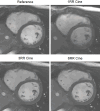Accelerated Cardiac MRI with Deep Learning-based Image Reconstruction for Cine Imaging
- PMID: 39540821
- PMCID: PMC11683685
- DOI: 10.1148/ryct.230419
Accelerated Cardiac MRI with Deep Learning-based Image Reconstruction for Cine Imaging
Abstract
Purpose To assess the influence of deep learning (DL)-based image reconstruction on acquisition time, volumetric results, and image quality of cine sequences in cardiac MRI. Materials and Methods This prospective study (performed from January 2023 to March 2023) included 55 healthy volunteers who underwent a noncontrast cardiac MRI examination at 1.5 T. Short-axis stack DL cine sequences of the left ventricle (LV) were performed over one (1RR), three (3RR), and six cardiac (6RR) cycles and compared with a standard cine sequence (without DL, performed over 10-12 cardiac cycles) in regard to acquisition time, subjective image quality, edge sharpness, and volumetric results. Results Total acquisition time (median) for a short-axis stack was 47 seconds for the 1RR cine, 108 seconds for 3RR cine, 184 seconds for 6RR cine, and 227 seconds for the standard sequence. Volumetric results showed no difference for the conventional cine (median LV ejection fraction [EF] 63%), 6RR cine (median LVEF, 62%), and 3RR cine (median LVEF, 61%). The 1RR cine sequence significantly underestimated EF (57%) because of a different segmentation of the papillary muscles. Subjective image quality (P = .37) and edge sharpness (P = .06) of the three-heartbeat DL cine did not differ from the reference standard, while both metrics were lower for single-heartbeat DL cine and higher for six-heartbeat DL cine. Conclusion For DL-based cine sequences, acquisition over three cardiac cycles appears to be the optimal compromise, with no evidence of differences in image quality, edge sharpness, and volumetric results, but with a greater than 50% reduced acquisition time compared with the reference sequence. Keywords: MR Imaging, Cardiac, Heart, Technical Aspects, Cardiac MRI, Deep Learning, Clinical Imaging, Accelerated Imaging Supplemental material is available for this article. © RSNA, 2024.
Keywords: Accelerated Imaging; Cardiac; Cardiac MRI; Clinical Imaging; Deep Learning; Heart; MR Imaging; Technical Aspects.
Conflict of interest statement
Figures





Similar articles
-
Accelerated cardiac magnetic resonance imaging using deep learning for volumetric assessment in children.Pediatr Radiol. 2024 Sep;54(10):1674-1685. doi: 10.1007/s00247-024-05978-6. Epub 2024 Jul 17. Pediatr Radiol. 2024. PMID: 39017676 Free PMC article.
-
Fast and Robust Single-Shot Cine Cardiac MRI Using Deep Learning Super-Resolution Reconstruction.Invest Radiol. 2025 Oct 1;60(10):669-678. doi: 10.1097/RLI.0000000000001186. Invest Radiol. 2025. PMID: 40184545
-
Prospective Comparison of Free-Breathing Accelerated Cine Deep Learning Reconstruction Versus Standard Breath-Hold Cardiac MRI Sequences in Patients With Ischemic Heart Disease.AJR Am J Roentgenol. 2024 May;222(5):e2330272. doi: 10.2214/AJR.23.30272. Epub 2024 Feb 7. AJR Am J Roentgenol. 2024. PMID: 38323784
-
Latest Advances in Image Acceleration: All Dimensions are Fair Game.J Magn Reson Imaging. 2023 Feb;57(2):387-402. doi: 10.1002/jmri.28462. Epub 2022 Oct 7. J Magn Reson Imaging. 2023. PMID: 36205716 Free PMC article. Review.
-
Cardiac MRI at Low Field Strengths.J Magn Reson Imaging. 2024 Feb;59(2):412-430. doi: 10.1002/jmri.28890. Epub 2023 Aug 2. J Magn Reson Imaging. 2024. PMID: 37530545 Free PMC article. Review.
Cited by
-
Qualitative and Quantitative Evaluation of a Deep Learning-Based Reconstruction for Accelerated Cardiac Cine Imaging.Bioengineering (Basel). 2025 Feb 24;12(3):231. doi: 10.3390/bioengineering12030231. Bioengineering (Basel). 2025. PMID: 40150695 Free PMC article.
-
Review of the Current State of Artificial Intelligence in Pediatric Cardiovascular Magnetic Resonance Imaging.Children (Basel). 2025 Mar 26;12(4):416. doi: 10.3390/children12040416. Children (Basel). 2025. PMID: 40310065 Free PMC article. Review.
References
-
- Currie G , Hawk KE , Rohren E , Vial A , Klein R . Machine learning and deep learning in medical imaging: intelligent imaging . J Med Imaging Radiat Sci 2019. ; 50 ( 4 ): 477 – 487 . - PubMed
-
- Orii M , Sone M , Osaki T , et al. . Reliability of respiratory-gated real-time two-dimensional cine incorporating deep learning reconstruction for the assessment of ventricular function in an adult population . Int J Cardiovasc Imaging 2023. ; 39 ( 5 ): 1001 – 1011 . - PubMed
MeSH terms
LinkOut - more resources
Full Text Sources

